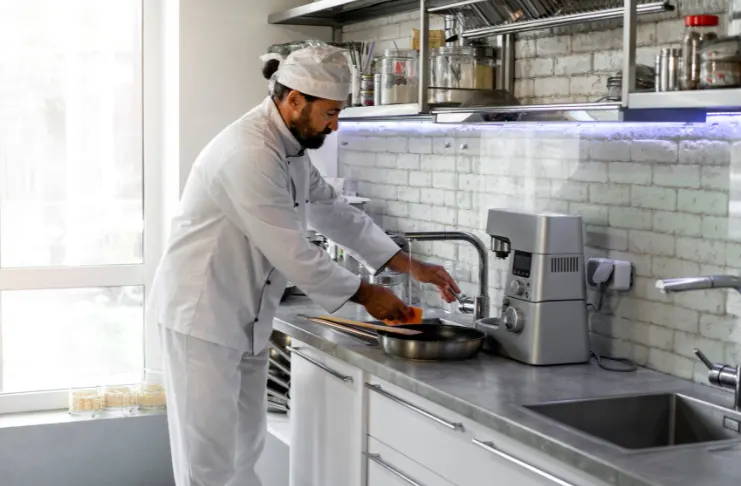The food service industry is undergoing a significant transformation with the emergence of the multi-brand cloud kitchen model. This innovative concept has redefined restaurant operations by removing the need for dine-in spaces and focusing solely on delivery. These cloud-based kitchens streamline operations, reduce overhead costs, and offer restaurant owners the flexibility to scale efficiently using delivery apps in today’s digital-first food economy.
A multi-brand cloud kitchen allows operators to run multiple virtual restaurant brands from a single kitchen infrastructure. This strategy enables restaurateurs to target diverse customer segments with different cuisines, without the burden of managing multiple storefronts. An effective virtual restaurant brand strategy helps businesses tailor menus, pricing, and promotions to meet evolving consumer preferences, maximizing brand visibility across various food delivery platforms and online delivery platforms.
As a powerful cloud kitchen business model innovation, this setup addresses major challenges faced by traditional restaurants, such as high rental expenses, staffing complexities, and limited physical capacity. By focusing on delivery and optimizing kitchen workflows, multi-brand kitchens boost productivity and customer reach. Ultimately, multi-brand kitchens increase profits by creating lean, tech-enabled operations that adapt quickly to market demands, making them the future of food entrepreneurship by significantly reducing operational costs.
Understanding the Multi-Brand Cloud Kitchen Concept
Understanding how multi-brand cloud kitchens operate is essential for restaurant entrepreneurs looking to scale efficiently and reduce costs while launching their own cloud kitchen and managing multiple virtual restaurant brands from a single smart kitchen infrastructure.
Defining Multi-Brand Operations
A multi-brand cloud kitchen is a single facility that houses multiple distinct restaurant brands, each with its own identity, menu, and target audience, while sharing the same commercial kitchen space and resources.
- Operates several unique restaurant brands under one roof, maximizing space and resources.
- Allows entrepreneurs to test multiple food concepts without the risks of separate physical locations.
- Provides operational flexibility to quickly adapt based on customer demand and market trends.
- Utilizes specialized kitchen stations to maintain food quality and brand integrity.
- Employs cross-trained staff to efficiently manage multiple brand requirements, improving labor productivity.
In summary, multi-brand cloud kitchens offer a cost-effective, flexible, and scalable model that empowers food entrepreneurs to diversify their offerings and respond swiftly to evolving customer preferences. This approach is reshaping the food service industry by driving innovation and operational efficiency for food businesses.
Core Components of Virtual Restaurant Brand Strategy
Virtual restaurant brand strategy focuses on creating and managing delivery-only food concepts that operate entirely online without physical storefronts. For this, owners should:
- Build distinct branding elements such as logos, packaging, and marketing materials tailored for digital platforms.
- Optimize their online presence and delivery platform profiles for maximum visibility and customer engagement.
- Design menus that maintain quality during delivery and appeal to specific target demographics.
- Use rapid testing and iteration based on customer feedback and market trends to refine offerings.
- Efficiently manage shared kitchen resources while keeping brand identities separate.
A strong virtual restaurant brand strategy helps owners create agile, delivery-focused brands that stand out in the competitive digital food market. According to a recent study, 41% of independent restaurants were operating virtual brands to meet the growing demand for food delivery.
Kitchen Infrastructure Requirements
Multi-brand cloud kitchens demand a thoughtfully designed infrastructure to support multiple distinct brands under one roof. For this, owners should:
- Implement specialized equipment layouts that accommodate diverse cooking methods and menu requirements simultaneously.
- Plan storage systems carefully to manage ingredients for various brands while ensuring food safety and preventing cross-contamination.
- Organize refrigeration, dry storage, and prep areas to maintain brand integrity and operational efficiency.
- Integrate advanced technology like point-of-sale systems, inventory management software, and order routing tools for smooth multi-brand operations.
- Use real-time data insights from technology to optimize kitchen workflow and resource allocation across brands.
In conclusion, a well-designed kitchen infrastructure is essential for multi-brand cloud kitchens to operate efficiently and maintain high-quality standards across all brands.
Effective multi-brand cloud kitchen success relies on strategic brand management within the restaurant business, combined with optimized kitchen infrastructure for scalable, efficient operations.
Cloud Kitchen Business Model Innovation

Innovative cloud kitchen business models unlock new revenue streams, boost operational efficiency, and leverage technology to drive scalable, multi-brand restaurant success in the delivery-first economy.
Revenue Stream Diversification
The innovative cloud kitchen model generates multiple revenue streams from one centralized operation. For this, owners should:
- Operate several brands targeting different market segments and dining occasions.
- Position complementary brands, like healthy options, alongside comfort food or diverse ethnic cuisines.
- Reduce risk by diversifying revenue sources and avoiding dependence on a single brand.
- Use dynamic pricing across brands based on demand, time, and competition.
- Maximize profitability during peak and off-peak hours with pricing flexibility.
In summary, revenue diversification through multi-brand kitchens helps operators reach wider markets and boost profitability efficiently.
Operational Efficiency Maximization
Multi-brand kitchens boost efficiency by sharing resources and streamlining operations. To achieve this, owners must:
- Coordinate kitchen equipment, staff, utilities, and delivery systems to support all brands simultaneously.
- Use sophisticated inventory management to share ingredients across brands, reducing waste and increasing purchasing leverage.
- Train staff across multiple brands to ensure flexible scheduling and minimize idle time during slower hours.
Overall, leveraging shared assets and flexible workforce management drives strong operational efficiency in multi-brand cloud kitchens.
Technology-Driven Operations
Technology plays a crucial role in optimizing multi-brand cloud kitchen operations. To capitalize on this, owners should:
- Implement advanced kitchen display systems to efficiently manage orders from various platforms and brands, ensuring smooth fulfillment and timing.
- Leverage data analytics to gain insights into customer preferences, order trends, and operational performance for smarter menu, pricing, and marketing decisions.
- Adopt automation tools such as inventory tracking and automated cooking equipment to boost efficiency and maintain consistency across all brands.
By embracing these technologies, cloud kitchens can enhance operational precision and scale effectively.
Innovative cloud kitchen models thrive by combining revenue diversification, operational efficiency, and smart delivery operations to scale profitable, multi-brand delivery businesses.
Strategic Planning and Implementation

Effective multi-brand cloud kitchen execution starts with data-driven market research, strategic location planning, and agile staffing models to ensure scalable, compliant, and customer-centric operations.
Market Research and Brand Development
Effective market research lays the foundation for successful multi-brand cloud kitchen ventures. For this, owners should:
- Analyze local demographics, food preferences, and competition to guide brand selection and positioning.
- Conduct pilot testing with limited menus to validate concepts and gather real customer feedback.
- Perform competitive analysis across food categories to identify market gaps and craft unique value propositions.
Thorough research and validation ensure that each virtual brand is strategically positioned to meet market demand and achieve success.
Location Selection and Setup
Choosing the right location and designing an efficient kitchen setup are key to smooth multi-brand cloud kitchen operations. To achieve this, owners should:
- Evaluate delivery radius, customer proximity, and driver accessibility to maximize service coverage.
- Optimize kitchen layout, equipment placement, and storage to support multiple brands and handle peak demand efficiently.
- Ensure compliance with health regulations and zoning laws through thorough documentation and permitting.
A well-planned location and setup enable operational efficiency, regulatory adherence, and superior customer reach.
Staffing and Training Strategies
Managing multiple brands under one kitchen demands tailored staffing strategies. To ensure success, cloud kitchen owners should:
- Equip kitchen managers with in-depth knowledge of all brand requirements to uphold quality and operational efficiency across diverse cuisines.
- Implement comprehensive cross-training programs to increase staff flexibility, enabling team members to support multiple brands as demand fluctuates.
- Develop detailed brand-specific quality control and training protocols alongside general kitchen safety and efficiency standards.
Effective staffing ensures consistent service quality, cost optimization, and smooth multi-brand kitchen operations.
Success in multi-brand cloud kitchens depends on smart planning, especially in the food delivery market, from market research and kitchen setup to staffing strategies that support scalable and customer-focused operations.
How Multi-Brand Kitchens Increase Profits

Multi-brand kitchens drive profitability through cost structure optimization, strategic revenue layering, and enhanced market penetration, maximizing output from a single operational hub.
Cost Structure Optimization
Multi-brand cloud kitchens boost profitability by optimizing their cost structures. To achieve this, owners should:
- Distribute fixed costs such as rent, utilities, and equipment across multiple brands, lowering the cost impact on each individual brand.
- Leverage economies of scale by negotiating better prices with suppliers through bulk purchasing of shared ingredients and packaging.
- Optimize labor costs by cross-utilizing staff across brands, keeping productivity high even during slower periods for specific brands.
This cost optimization strategy enables multi-brand kitchens to enhance margins and sustain growth efficiently.
Revenue Multiplication Strategies
The multi-brand model drives revenue growth by targeting diverse customer segments and dining occasions. To capitalize on this, owners should:
- Operate complementary brands, such as breakfast concepts alongside dinner options, to maximize kitchen use throughout the day.
- Implement flexible menu pricing across brands to attract both premium and value-focused customers, broadening the overall market reach.
- Launch seasonal or limited-time brands for holidays and special events, creating additional revenue streams without long-term commitments or extra infrastructure.
By diversifying offerings, multi-brand kitchens can unlock new income opportunities and optimize daily sales potential.
Market Penetration Advantages
Multi-brand strategies drive deeper market penetration by catering to diverse customer preferences, all from one centralized location. For this, owners should:
- Offer a wide variety of food categories and target multiple customer demographics to capture a broader and more diverse market share.
- Actively manage their brand portfolio, allowing quick adaptation to evolving market trends and rapid launch of new virtual brands with minimal upfront investment.
- Leverage proven brand concepts for efficient geographic expansion, replicating successful operational models in new markets with refined processes and local insights.
- In the U.S., a significant 88.43% of consumers prefer digital food ordering, highlighting the importance of an online presence for multi-brand cloud kitchens.
This comprehensive approach strengthens competitive positioning and accelerates scalable growth opportunities across multiple regions.
INDUSTRY INSIGHT
| According to a report by Kings Research, the multi-brand cloud kitchen model secured the largest revenue share of 36.78% in 2023, exemplifying the industry’s shift towards digital and diversified culinary offerings. |
Multi-brand cloud kitchens maximize profit potential by streamlining costs, layering revenue sources, and expanding market reach—all from a single, efficient operational hub.
Operational Excellence in Multi-Brand Environments

Optimizing kitchen workflow, inventory management, and quality assurance is essential for multi-brand cloud kitchens to deliver consistent food quality and efficient operations across diverse virtual brands.
Kitchen Workflow Optimization
Efficient kitchen workflow design is essential to ensure smooth operations across multiple brands without sacrificing food quality or delivery speed. To achieve this, owners should:
- Strategically place equipment and organize prep stations to enable quick and seamless switching between different brand menus.
- Implement advanced order management systems that prioritize and sequence orders from various brands, using smart algorithms to balance timing and optimize kitchen throughput.
- Establish rigorous quality control checkpoints throughout the cooking process to maintain each brand’s unique standards, with clear protocols to prevent cross-contamination of flavors and presentation styles.
By focusing on these key areas, multi-brand kitchens can maintain operational excellence while delivering consistent, high-quality meals across all brands.
Inventory Management Systems
Effective inventory management is crucial for multi-brand cloud kitchens to optimize costs and maintain quality. For this, owners should:
- Use sophisticated inventory management systems to track ingredients across all brands in real time, preventing stockouts and minimizing excess inventory costs.
- Maximize purchasing efficiency by sharing common ingredients across brands through smart menu engineering, while preserving each brand’s unique flavor profile and identity.
- Develop strategic supplier relationships that leverage the increased volume and purchasing power of multi-brand operations, securing consistent quality and competitive pricing through long-term partnerships.
Implementing these strategies helps multi-brand kitchens reduce waste, control costs, and ensure smooth, uninterrupted operations.
Quality Assurance Protocols
Maintaining consistent quality across multiple brands demands a systematic and thorough approach. For this, owners should:
- Implement regular auditing processes to ensure each brand consistently meets its specific quality benchmarks and standards.
- Enforce strict temperature control and food safety protocols tailored to diverse preparation methods, while adhering to all health regulations and preventing cross-contamination in shared kitchen spaces.
- Monitor customer feedback across all brands closely to identify quality consistency issues and areas needing improvement, using data-driven insights for continuous operational enhancement.
These focused quality assurance strategies help multi-brand kitchens uphold their brand promises and deliver exceptional customer experiences.
Optimizing workflows and inventory systems enables multi-brand cloud kitchens to operate efficiently while consistently delivering high-quality meals across diverse virtual restaurant concepts.
Technology Integration and Management

Digital platform optimization, data analytics, and automation tools are critical for multi-brand cloud kitchens to maximize online visibility, operational efficiency, and profitability across diverse virtual restaurant brands.
Digital Platform Optimization
Managing multiple virtual brands requires advanced digital platform strategies. For this, owners should:
- Optimize profiles and menus for each brand on all delivery platforms.
- Run tailored promotional campaigns to boost visibility.
- Enhance search engine optimization with strong listings and keyword use.
- Actively manage customer reviews for reputation building.
- Develop distinct social media content for each brand.
- Engage customers through targeted and consistent brand messaging.
Smart digital management helps multi-brand kitchens reach more customers and increase orders effectively.
Data Analytics and Performance Tracking
Effective data analytics is crucial for managing multiple virtual brands. To achieve this, owners should:
- Use analytics platforms to monitor performance metrics across all brands.
- Analyze customer behavior to understand ordering trends and preferences.
- Apply insights to optimize menus and tailor marketing campaigns.
- Track financial performance to assess profitability by brand.
- Allocate resources based on data-driven profitability analysis.
- Prioritize investments in high-performing brands for growth.
Data-driven decisions empower multi-brand operators to enhance efficiency and maximize profits.
Automation and Efficiency Tools
Automation plays a vital role in optimizing multi-brand cloud kitchens. To achieve this, owners should:
- Implement automated cooking equipment and portion control systems for consistent food quality.
- Use integrated order management platforms to streamline operations across brands.
- Adopt inventory automation for real-time stock tracking and error reduction.
- Utilize automated reordering systems to maintain a steady ingredient supply without overstocking.
- Employ customer communication automation for seamless order updates and feedback collection.
Automation improves operational efficiency while maintaining high service standards across all brands.
It is believed that 30% of cloud kitchens are expected to implement AI-based plate-specific offerings to improve customer satisfaction, automation, and efficiency.
Digital optimization, data-driven insights, and automation empower multi-brand cloud kitchens to scale efficiently, boost profitability, and consistently deliver superior customer experiences across all virtual brands.
Marketing and Brand Management

Developing strong individual brand identities and executing coordinated cross-brand digital marketing strategies are essential for multi-brand cloud kitchens to build customer loyalty, boost visibility, and drive sustained growth across virtual restaurant portfolios.
Individual Brand Identity Development
Creating distinct identities for each virtual brand is essential for success. To achieve this, it’s important to:
- Develop unique visual branding that sets each brand apart in the portfolio.
- Craft menu positioning tailored to specific target audiences and preferences.
- Build compelling brand storytelling, emphasizing food quality and unique value propositions.
- Design packaging that enhances brand recognition and ensures delivery functionality.
- Implement tailored customer communication strategies to maintain brand differentiation.
Strong brand identities boost customer loyalty and recognition, even without physical storefronts.
Cross-Brand Marketing Strategies
To fully leverage multi-brand marketing potential, it’s important to:
- Use customer databases across brands to boost order frequency and lifetime value.
- Coordinate promotional campaigns that drive traffic between different brands in the portfolio.
- Introduce satisfied customers from one brand to others via targeted acquisition campaigns.
- Integrate loyalty programs across brands to enhance retention and increase average order values.
Cross-brand marketing creates synergy that drives revenue growth and strengthens customer relationships.
Digital Marketing Excellence
Digital marketing is crucial for virtual brands to build visibility and drive online orders effectively. To achieve this, operators should:
- Implement specialized search engine marketing focusing on local SEO and delivery platform optimization.
- Develop targeted advertising campaigns to drive orders through digital channels.
- Create engaging content that highlights food quality, preparation, and unique brand personalities across social media.
- Partner with influencers and food bloggers to boost brand credibility and online visibility.
These strategies help virtual brands thrive in a crowded marketplace without physical storefronts.
Building powerful brand identities and executing integrated cross-brand digital marketing enables multi-brand cloud kitchens to foster customer loyalty, enhance visibility, and accelerate long-term growth.
Financial Management and Profitability

Effective cost accounting and strategic revenue optimization are critical for multi-brand cloud kitchens to maximize profitability, guide smart investment decisions, and fuel scalable growth across diverse virtual restaurant brands.
Cost Accounting Across Brands
Accurate cost accounting is essential for managing profitability in multi-brand cloud kitchens. To achieve this, operators should:
- Sophisticated tracking of direct and indirect costs across all brands ensures clarity on true profitability.
- Fixed costs are allocated fairly based on revenue contribution or kitchen usage to reflect actual resource consumption.
- Variable costs like ingredients, packaging, delivery, and marketing are monitored separately for each brand.
- Detailed cost analysis helps identify opportunities for improving margins and optimizing operations.
Effective cost accounting empowers operators to make informed financial and strategic decisions.
Revenue Optimization Strategies
To optimize revenue and profitability across multiple brands, operators should:
- Implement dynamic pricing strategies based on demand, competition, and customer price sensitivity.
- Focus on menu mix optimization by promoting high-margin items while ensuring customer satisfaction and consistent order frequency.
- Measure the effectiveness of promotional campaigns across brands to identify successful strategies.
- Use these insights to optimize promotional spending for the highest return on investment.
By applying these strategies, operators can maximize profitability while maintaining strong market competitiveness across all their brands.
Investment Planning and Growth
Effective capital allocation and growth planning are essential for scaling multi-brand cloud kitchens sustainably and profitably.
- Operators should analyze expansion opportunities, equipment upgrades, and new brand initiatives to ensure the best return on investment.
- Scalability planning helps determine the ideal number of brands per kitchen without sacrificing quality or efficiency.
- Growth funding can come from reinvesting profits into new concepts or expanding successful brands into new markets.
Strategic investment and careful growth management enable long-term success in multi-brand cloud kitchen operations.
Mastering cost control, revenue strategies, and smart investment planning enables multi-brand cloud kitchens to drive sustainable profitability and scalable growth in a competitive delivery-first market.
Challenges and Solutions

Managing operational complexity, maintaining quality control, and responding to intense market competition are essential challenges multi-brand cloud kitchens must strategically address to ensure seamless efficiency and sustainable growth.
Operational Complexity Management
Managing multiple brands under one roof introduces operational complexities that demand organized and systematic solutions in comparison to a normal brick and mortar restaurant .
- Operators should implement standardized procedures and clear communication protocols to maintain efficiency and quality.
- Comprehensive staff training and clear guidelines reduce confusion and minimize errors across different brand requirements.
- Preventive maintenance and backup equipment strategies help manage shared resources and avoid disruptions.
By addressing these challenges proactively, multi-brand kitchens can ensure smooth, consistent operations across all brands.
Quality Control Challenges
Maintaining high-quality standards across multiple brands in shared kitchen spaces demands rigorous quality control measures.
- Operators must implement robust quality control systems with regular monitoring to uphold each brand’s specific standards.
- Strict separation protocols and thorough cleaning procedures are essential to prevent cross-contamination, especially with allergens and distinct flavors.
- Continuous staff training and frequent quality audits ensure consistent preparation methods and presentation across all brands.
These practices help preserve brand integrity and deliver a reliable customer experience for every virtual restaurant.
Market Competition Response
Multi-brand cloud kitchens face intense competition from traditional restaurants and other virtual kitchens, demanding strategic approaches to stay ahead.
- Operators should leverage multi-brand advantages to address competitive pressures effectively.
- Building customer loyalty is crucial, especially for virtual brands without physical presence; this requires superior food quality, consistent service, and strong customer engagement.
- Reducing platform dependency by diversifying across multiple delivery services and developing direct ordering channels safeguards business stability.
By tackling these challenges strategically, multi-brand operators can strengthen their market position and ensure long-term success.
Successfully managing complexity, ensuring quality, and staying competitive empowers multi-brand cloud kitchens to thrive in the dynamic, delivery-first food service landscape.
Future Trends and Opportunities

The evolution of technology, market expansion opportunities, and industry trends are driving multi-brand cloud kitchens to revolutionize food service, enabling scalable growth, operational efficiency, and innovative customer experiences across virtual restaurant brands.
Technology Evolution Impact
The integration of cutting-edge technologies is reshaping multi-brand cloud kitchens, driving efficiency and enhancing customer engagement.
- AI and machine learning improve demand forecasting, inventory management, and enable personalized marketing across brands.
- Robotics and automation boost operational consistency, reduce labor costs, and minimize human errors in food preparation and delivery.
- Virtual and augmented reality open new possibilities for immersive virtual brand experiences, even without physical dining spaces.
Leveraging these technologies empowers multi-brand kitchens to optimize operations and create innovative customer experiences for sustained growth.
Market Expansion Potential
Expanding multi-brand cloud kitchens offers significant growth opportunities both locally and internationally.
- Geographic expansion allows proven multi-brand concepts to replicate success in new markets with established operational models.
- International growth is achievable by adapting virtual brands to local tastes while maintaining efficiency and brand consistency.
- Franchise models enable rapid scaling through partnerships with local operators, accelerating market penetration and brand reach.
By strategically leveraging these expansion avenues, operators can maximize growth and build a strong global presence.
Industry Evolution Predictions
The ghost kitchen industry is rapidly evolving toward sophisticated multi-brand operations, driven by profitability and operational efficiency benefits.
- Multi-brand models are increasingly integrating with grocery retail and meal kit services, opening new revenue streams and customer engagement channels.
- Sustainability is becoming a priority, with shared resources enabling eco-friendly practices across multiple brands and optimized logistics.
- This model marks a major shift in food service, offering entrepreneurs scalable and profitable opportunities through careful planning and strategic brand management.
- Effective multi-brand strategies empower operators to serve diverse customers, build resilient businesses, and thrive in the dynamic food delivery landscape.
Success will favor those who can expertly manage operational complexities while delivering exceptional customer experiences across all virtual brands.
Multi-brand cloud kitchens are redefining the future of food service by merging technology, market agility, and strategic innovation to deliver scalable, efficient, and customer-centric virtual dining experiences.
Conclusion
The rise of the multi-brand cloud kitchen marks a transformative era in the food service industry. As highlighted earlier, this model reimagines restaurant operations by eliminating dine-in spaces and focusing on digital-first, delivery-only concepts. With smart implementation and strategic planning, multi-brand cloud kitchens empower food entrepreneurs to scale rapidly while keeping overheads low and profitability high.
By leveraging a strong virtual restaurant brand strategy, operators can cater to diverse customer segments with distinct culinary identities—all within a single kitchen infrastructure. This level of brand flexibility, paired with centralized resources, makes the model an exceptional example of cloud kitchen business model innovation. It enables dynamic pricing, inventory efficiency, and labor optimization that traditional restaurant models simply can’t match.
Ultimately, multi-brand kitchens increase profits by creating multiple revenue streams, maximizing kitchen utilization, and rapidly responding to market trends. They provide a scalable, cost-efficient, and tech-enabled path forward for modern food entrepreneurs. As consumer demand continues to shift toward convenience, variety, and speed, the multi-brand cloud kitchen stands out as the most agile and profitable solution.
Operators who embrace this model today are setting the foundation for long-term success in the future of food service.
Frequently Asked Questions
1. What is a multi-brand kitchen?
A multi-brand kitchen is a single commercial kitchen that operates multiple virtual restaurant brands under one roof.
2. Which is the biggest cloud kitchen company?
The biggest cloud kitchen company is Reef Technology, followed closely by CloudKitchens and Kitopi globally.
3. What happened to CloudKitchens?
CloudKitchens is still operational but has faced scrutiny over leadership, data privacy, and aggressive expansion tactics.
4. Is cloud kitchen legal in the USA?
Cloud kitchens are legal in the USA as long as they comply with local health, zoning, and business regulations.
5. What is a virtual restaurant brand?
A virtual restaurant brand is a delivery-only food concept that exists online without a physical dine-in location.
6. What’s the difference between a ghost kitchen and a virtual restaurant?
A ghost kitchen is the facility where food is prepared, while a virtual restaurant is a brand selling that food online.
7. What is the virtual kitchen business model?
The virtual kitchen business model involves operating delivery-only food brands from centralized kitchens using online platforms.
8. What does a virtual brand on DoorDash mean?
A virtual brand on DoorDash is a delivery-only restaurant that appears on the app but operates from an existing kitchen.





